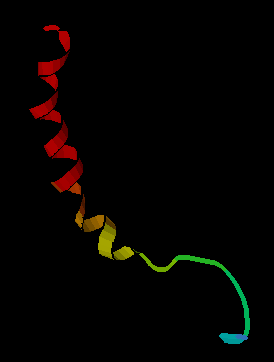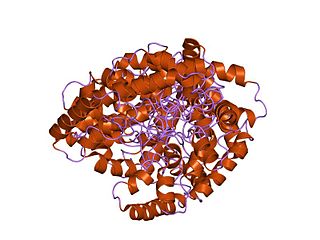Related Research Articles
Juvenile hormones (JHs) are a group of acyclic sesquiterpenoids that regulate many aspects of insect physiology. The first discovery of a JH was by Vincent Wigglesworth. JHs regulate development, reproduction, diapause, and polyphenisms.The chemical formula for juvenile hormone is .

Cholecystokinin is a peptide hormone of the gastrointestinal system responsible for stimulating the digestion of fat and protein. Cholecystokinin, formerly called pancreozymin, is synthesized and secreted by enteroendocrine cells in the duodenum, the first segment of the small intestine. Its presence causes the release of digestive enzymes and bile from the pancreas and gallbladder, respectively, and also acts as a hunger suppressant.

Neuropeptides are chemical messengers made up of small chains of amino acids that are synthesized and released by neurons. Neuropeptides typically bind to G protein-coupled receptors (GPCRs) to modulate neural activity and other tissues like the gut, muscles, and heart.

In animal dormancy, diapause is the delay in development in response to regular and recurring periods of adverse environmental conditions. It is a physiological state with very specific initiating and inhibiting conditions. The mechanism is a means of surviving predictable, unfavorable environmental conditions, such as temperature extremes, drought, or reduced food availability. Diapause is observed in all the life stages of arthropods, especially insects.

Octopamine (molecular formula C8H11NO2; also known as OA, and also norsynephrine, para-octopamine and others) is an organic chemical closely related to norepinephrine, and synthesized biologically by a homologous pathway. Octopamine is often considered the major "fight-or-flight" neurohormone of invertebrates. Its name is derived from the fact that it was first identified in the salivary glands of the octopus.

FMRFamide (H-Phe-Met-Arg-Phe-NH2) is a neuropeptide from a broad family of FMRFamide-related peptides (FaRPs) all sharing an -RFamide sequence at their C-terminus. First identified in Hard clam, it is thought to play an important role in cardiac activity regulation. Several FMRFamide related peptides are known, regulating various cellular functions and possessing pharmacological actions, such as anti-opiate effects. In Mercenaria mercenaria, FMRFamide has been isolated and demonstrated to increase both the force and frequency of the heartbeat through a biochemical pathway that is thought to involve the increase of cytoplasmic cAMP in the ventricular region.
Neuromodulation is the physiological process by which a given neuron uses one or more chemicals to regulate diverse populations of neurons. Neuromodulators typically bind to metabotropic, G-protein coupled receptors (GPCRs) to initiate a second messenger signaling cascade that induces a broad, long-lasting signal. This modulation can last for hundreds of milliseconds to several minutes. Some of the effects of neuromodulators include: alter intrinsic firing activity, increase or decrease voltage-dependent currents, alter synaptic efficacy, increase bursting activity and reconfiguration of synaptic connectivity.

Galanin is a neuropeptide encoded by the GAL gene, that is widely expressed in the brain, spinal cord, and gut of humans as well as other mammals. Galanin signaling occurs through three G protein-coupled receptors.
Signaling peptide receptor is a type of receptor which binds one or more signaling peptides or signaling proteins.

Carboxypeptidase E (CPE), also known as carboxypeptidase H (CPH) and enkephalin convertase, is an enzyme that in humans is encoded by the CPE gene. This enzyme catalyzes the release of C-terminal arginine or lysine residues from polypeptides.

Galanin receptor 2, (GAL2) is a G-protein coupled receptor encoded by the GALR2 gene.
Crustacean cardioactive peptide (CCAP) is a highly conserved, amidated cyclic nonapeptide with the primary structure PFCNAFTGC-NH2 (ProPheCysAsnAlaPheTyrGlyCys-NH2) and a disulfide bridge between Cys3 and Cys9. It is found in crustaceans and insects where it behaves as a cardioaccelerator, neuropeptide transmitter for other areas of the nervous system and a hormone. CCAP was first isolated from the pericardial organs of the shore crab Carcinus maenas, where it has a role in regulating heartbeat. It was assumed that this was the peptide's main function and its name reflects this.
Corazonin is a highly conserved neuropeptide found in many insects, in particular locusts and cockroaches.

The halloween genes are a set of genes identified in Drosophila melanogaster that influence embryonic development. All of the genes code for cytochrome P450 enzymes in the ecdysteroidogenic pathway (biosynthesis of ecdysone from cholesterol). Ecdysteroids such as 20-hydroxyecdysone and ecdysone influence many of the morphological, physiological, biochemical changes that occur during molting in insects.
The pheromone biosynthesis activation neuropeptide (PBAN) is a neurohormone that activates the biosynthesis of pheromones in moths. Female moths release PBAN into their hemolymph during the scotophase to stimulate the biosynthesis of the unique pheromone that will attract the conspecific males. PBAN release is drastically reduced after mating, contributing to the loss in female receptivity. In black cutworm, it has been shown that the juvenile hormone helps induce release of PBAN which goes on to influence pheromone production and responsiveness in females and males, respectively. In the oriental tobacco budworm, the circadian rhythm of pheromone production is closely associated with PBAN release.
Pigment dispersing factor (pdf) is a gene that encodes the protein PDF, which is part of a large family of neuropeptides. Its hormonal product, pigment dispersing hormone (PDH), was named for the diurnal pigment movement effect it has in crustacean retinal cells upon its initial discovery in the central nervous system of arthropods. The movement and aggregation of pigments in retina cells and extra-retinal cells is hypothesized to be under a split hormonal control mechanism. One hormonal set is responsible for concentrating chromatophoral pigment by responding to changes in the organism's exposure time to darkness. Another hormonal set is responsible for dispersion and responds to the light cycle. However, insect pdf genes do not function in such pigment migration since they lack the chromatophore.

In molecular biology, the crustacean neurohormone family of proteins is a family of neuropeptides expressed by arthropods. The family includes the following types of neurohormones:
Neuropeptide VF precursor, also known as pro-FMRFamide-related neuropeptide VF or RFamide-related peptide precursor, is a propeptide that in mammals is encoded by the NPVF (or RPFP) gene. The NPVF gene, and thus the propeptide, are expressed in neurons in the mediobasal hypothalamus. The propeptide is cleaved to form three other peptides, which are:
The amnesiac (amn) gene in Drosophila is a mutant suppressor of the dunce gene. The gene produces a neuropeptide of the same name.
Juvenile hormone acid O-methyltransferase (JHAMT) is a ~33 kDa enzyme that catalyzes the conversion of inactive precursors of Juvenile hormones (JHs) to active JHs in the final stages of JH biosynthesis in the corpora allata of insects. More specifically, the enzyme catalyzes the transfer of a methyl group from S-adenosyl-L-methionine (SAM) to the carboxylate group of JH precursors.
References
- 1 2 Stay B, Tobe SS (2007). "The role of allatostatins in juvenile hormone synthesis in insects and crustaceans". Annu. Rev. Entomol. 52: 277–99. doi:10.1146/annurev.ento.51.110104.151050. PMID 16968202.
- ↑ Gäde G, Goldsworthy GJ (2003). "Insect peptide hormones: a selective review of their physiology and potential application for pest control". Pest Manag. Sci. 59 (10): 1063–75. doi:10.1002/ps.755. PMID 14561063.
- ↑ Veenstra, Jan A. (2016-05-01). "Allatostatins C, double C and triple C, the result of a local gene triplication in an ancestral arthropod". General and Comparative Endocrinology. 230–231: 153–157. doi:10.1016/j.ygcen.2016.04.013. ISSN 0016-6480. PMID 27102937.
- 1 2 Wegener, Christian; Chen, Jiangtian (2022). "Allatostatin A Signalling: Progress and New Challenges From a Paradigmatic Pleiotropic Invertebrate Neuropeptide Family". Frontiers in Physiology. 13: 920529. doi: 10.3389/fphys.2022.920529 . ISSN 1664-042X. PMC 9263205 . PMID 35812311.
- ↑ Nässel, Dick R.; Zandawala, Meet (2019-08-01). "Recent advances in neuropeptide signaling in Drosophila, from genes to physiology and behavior". Progress in Neurobiology. 179: 101607. doi:10.1016/j.pneurobio.2019.02.003. ISSN 0301-0082. PMID 30905728. S2CID 84846652.
- ↑ Birgül, N.; Weise, C.; Kreienkamp, H. J.; Richter, D. (1999-11-01). "Reverse physiology in drosophila: identification of a novel allatostatin-like neuropeptide and its cognate receptor structurally related to the mammalian somatostatin/galanin/opioid receptor family". The EMBO Journal. 18 (21): 5892–5900. doi:10.1093/emboj/18.21.5892. ISSN 0261-4189. PMC 1171655 . PMID 10545101.